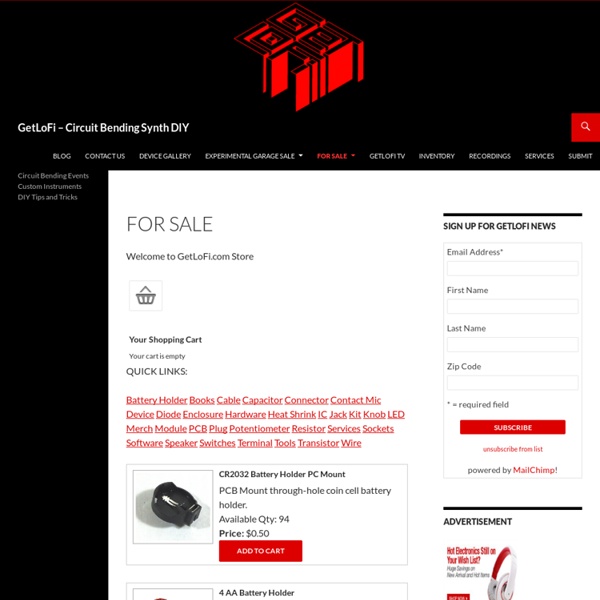



Nonfinite Electronics - Your Source For Everything Game Boy Related! Wallpaper Videos See the universe come to life via animations, scientific visualizations, expert commentary, and more. circuit-bending YOU can circuit-bend. The following discussion will start new benders on the right path. Also see the Anti-Theory Workshop section, the various instrument galleries and the PSF interview with Reed for additional insights into the process. If you learn to solder and can drill a small hole to mount a switch in, you can circuit-bend. Audio toys not only are easy to circuit-bend, but also are capable of sonic eccentricities beyond belief. Also important, audio toys are low-voltage devices.
Tim Kaiser Come costruire un essiccatore per alimenti homemade Tutto è partito dal costo dei fichi secchi bio…un furto! Poi da tempo, avendo acquistato e letto "solo crudo" si è fatta largo in me l’idea della necessità di aumentare la quantità nella mia alimentazione di cibi non cotti. L'essicazione non fà altro che togliere l'acqua agli alimenti e permette così una buona e lunga conservazione del cibo senza che esso venga attaccato da muffe e funghi, e poi dà un gusto meraviglioso poter mangiare delle albicocche in pieno inverno….che non arrivino da serre o dall'altro capo del mondo sapendo che sono bio e homemade perché essiccate da sé! Certo il massimo sarebbe (come in Sicilia!) essiccare al sole ma…chi lo vede il sole se non è agosto qui dalle mie parti!…perciò ecco spiegata la voglia di "costruire un essiccatore!" Certo ne esistono decine in commercio perciò potete pure comprarvelo…ma a parte il costo molto alto siete sicuri che vi darà le stesse soddisfazioni?! E allora….via! foto e testi: Kia - Carmela Giambrone Potrebbe interessarti anche:
Circuit bending Probing for "bend" using a jeweler's screwdriver and alligator clips Circuit bending is the creative, chance-based customization of the circuits within electronic devices such as low voltage, battery-powered guitar effects, children's toys and digital synthesizers to create new musical or visual instruments and sound generators. Emphasizing spontaneity and randomness, the techniques of circuit bending have been commonly associated with noise music, though many more conventional contemporary musicians and musical groups have been known to experiment with "bent" instruments. Circuit bending usually involves dismantling the machine and adding components such as switches and potentiometers that alter the circuit. Experimental process[edit] A 1989 Kawasaki toy guitar used in a circuit bending project A Yamaha PSR-6 used in a circuit bending project. Innovators[edit] In 2009, circuit bending rock band CMKT 4 began touring America teaching workshops on circuit bending and DIY electronics. [9]
Nicolas Collins Bent Festival 2011 Bent is an annual art and music festival celebrating circuit bending and its related creative practices: DIY electronics, hardware hacking, glitch, code bending, software art, abstract video. Now in its 8th year, the festival is a public summit where artists from across the country and around the globe gather to share their craft through performances, workshops, video screenings, art exhibitions, and installations, showcasing the state of the art in DIY electronics and circuit bending culture. If you’re the slightest bit curious about electronics, electronic music, handmade electronic art, or if you’ve ever just really wanted to rip your toys apart, Bent Festival is here. On Friday the 24th and Saturday the 25th, we are offering a range of presentations and workshops including the infamous intro to circuit bending workshop with expert benders on hand to help you get started. What is Circuit Bending? Circuit bending is the direct result of experimentation, exploration, and play.
Experimentalists Anonymous